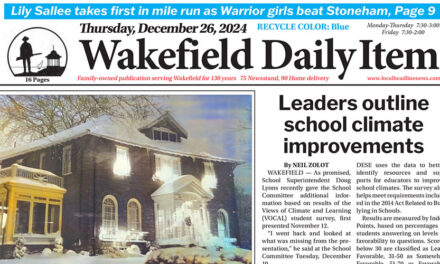Published in the June 28, 2021 edition
By MARK SARDELLA
WAKEFIELD — A fiscal impact study prepared for Cabot Cabot and Forbes claims that the real estate development giant’s proposal to build 485 housing units at the head of the Lake would will result in a net annual positive fiscal impact for the town of $543,856.
This means that projected tax revenue from the project would outstrip municipal costs for services related to the development by over half-a-million dollars, according to Mark J. Fougere of Fougere Planning and Development out of Milford New Hampshire. Fougere was hired by CC&F to perform the fiscal impact study, which he presented at last week’s meeting of the Zoning Board of Appeals.
CC&F is currently in hearings before the ZBA and is seeking Special Permits that would allow the construction of 485 units of housing, plus a restaurant/café, in three buildings at 200-400 Quannapowitt Parkway, the former site of Comverse and American Mutual.
According to the report, the development is expected to mainly impact a few town departments, most notably the School Department, Police and Fire departments. Other town agencies are projected to experience minimal impacts from the project.
Fougere estimates that the development would generate a total of $1,765,295 in yearly revenues from property and excise taxes.
He also calculated the likely impact that the project would have on town services and the corresponding cost of that impact. After determining that the greatest impact would be on the Police, Fire and School departments, he conferred with Police Chief Steven Skory, Fire Chief Michael Sullivan and School Superintendent Doug Lyons. Fougere told the ZBA that all three department heads agreed that the numbers he arrived at represented good estimates of the financial impact of the project.
He estimated the proposed project to add $160,680 in annual costs to the police budget, based on an estimated number of calls for service and the cost per call. (CC&F believes the police-relate impact will be much lower due to elaborate security systems planned for the project.)
Fougere set the fiscal impact on the Fire Department at $228,384 per year.
He estimated that when fully occupied, the proposed development would add 55 students to the Wakefield schools. He projected the annual financial impact on the schools at $796,000.
Subtracting the projected costs from the estimated tax revenue, Fougere came up with a positive financial impact on the town of $543,856 annually.
Fougere insisted that he took a conservative approach in developing the Fiscal Impact Report, using figures favorable to the town’s interests whenever possible. He said that he presented the report to Town Administrator Stephen P. Maio and Economic Development Director Erin Kokinda and they both concurred that Fougere had used a conservative approach in developing the estimates in the report.
ZBA member Chip Tarbell said that he was expecting more on the economic impact of the project beyond just the impact on the town’s finances. CC&F project manager Matt D’Amico said that he would work on a an expanded report to include economic impact.
When the hearing was opened to public testimony, Bronwyn Della-Volpe of Cyrus Street questioned any claims that might be made for the project’s ability to revitalize the downtown. She claimed that such claims are made for every development and never materialize.
CC&F attorney Brian McGrail disagreed, saying that a number of the restaurants in the downtown area have reported benefitting from new residents coming into town.
Rick Stewart of Salem Street questioned the estimated amount of excise tax revenue used in the report. He also wondered if the report took into account the likelihood that some of the students added to the school system might have special needs.
Another resident said that he wanted to see the project have more of a commercial mix.
There was some discussion about when the hearings would focus on the size of the project. Several members of the board felt that they needed to hear all of the ancillary information first, like fiscal, traffic and other impacts that could dictate changes to the project.
The board continued the hearing to July 14, when the focus is expected to be on traffic. Board members also expressed an interest in hearing directly from the police and fire chiefs, as well as the school superintendent, regarding the impact of the project on their departments.




